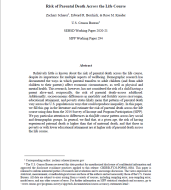
An official website of the United States government
Here’s how you know
Official websites use .gov
A .gov website belongs to an official government organization in the United States.
Secure .gov websites use HTTPS
A lock (
) or https:// means you’ve safely connected to the .gov website. Share sensitive information only on official, secure websites.
-
//
- Census.gov /
- Library /
- Census Working Papers /
- Risk of Parental Death Across the Life Course
Risk of Parental Death Across the Life Course
Risk of Parental Death Across the Life Course
Relatively little is known about the risk of parental death across the life course, despite its importance for multiple aspects of wellbeing. Demographic research has documented the ways in which parental transfers to adult children (and from adult children to their parents) affect economic circumstances, as well as physical and mental health. This research, however, has not considered the risk of a child having a parent alive–and, reciprocally, the risk of parental death–across adulthood. Additionally, socioeconomic differences in mortality and fertility across race/origin, educational attainment, and poverty status likely mean that patterns of parental death vary across the U.S. population in ways that could reproduce inequality. In this paper, we fill this gap in the literature and estimate the risk of parental death across the life course using data from the 2014 Survey of Income and Program Participation (SIPP). We pay particular attention to differences in this life course pattern across key social and demographic groups. In general, we find that, at a given age, the risk of having experienced paternal death is higher than that of maternal death, and that those in poverty or with lower educational attainment are at higher risk of parental death across the life course.
Share
Related Information
WORKING PAPER
Families and Households Working PapersSome content on this site is available in several different electronic formats. Some of the files may require a plug-in or additional software to view.
 Yes
Yes
 No
NoComments or suggestions?


Top

